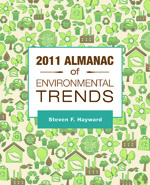San Francisco—Improvements seen across key environmental indicators should be cause for celebration this Earth Day, according to Steven F. Hayward, Ph.D., author of the new book Almanac of Environmental Trends, released by the Pacific Research Institute (PRI), a California-based free market think tank.
“The Almanac is an example of the creative destruction of the marketplace, or in the language of popular culture, a ‘reboot’ of an old franchise, the Index of Leading Environmental Indicators,” said Dr. Hayward, a PRI senior fellow. The Index was published annually by the Pacific Research Institute and the American Enterprise Institute for nearly 15 years. Like the Index, the Almanac and the interactive website www.environmentaltrends.org explore the nature and sources of environmental progress, affirming the central role of markets, technology, and human creativity in solving the environmental challenges of our time. “But instead of a once-a-year printed report released on Earth Day, the Almanac and the interactive website bring tracking environmental progress fully into the 21st century of real-time analysis and commentary,” Dr. Hayward said.
The Almanac of Environmental Trends covers seven major indicators of environmental progress including (1) Air Quality, (2) Energy, (3) Climate Change, (4) Water Quality, (5) Toxic Chemicals, (6) Forests and Land, and (7) Biodiversity. Examples of progress include:
- In general the U.S. has improved water use efficiency by about 30 percent over the last 30 years.
- Wetlands are now increasing in the U.S. after having declined for more than two centuries before the 1990s.
- Forestlands in the U.S. have been expanding rapidly over the last 30 years, and the global rate of deforestation appears to be steadily declining.
- The total amount of toxic chemicals used in American industry is steadily declining – a measure of resource efficiency.
- Virtually the entire nation has achieved clean air standards for four of the six main pollutants regulated under the Clean Air Act.
“Most environmental commentary dwells on the laws and regulations we have adopted to achieve our goals, but it is essential to understand the more important role of technology and economic growth in bringing about favorable environmental trends,” said Dr. Hayward. “Because the general public remains largely unaware of these trends, as is our mission since the 1990s, PRI endeavors to illuminate the progress that has occurred and highlight the lessons that can be learned from environmental improvements including the correlation of wealth and prosperity and environmental quality and the centrality of property rights and the rules of law to environmental protection.”


